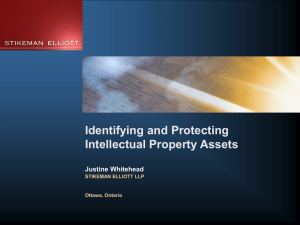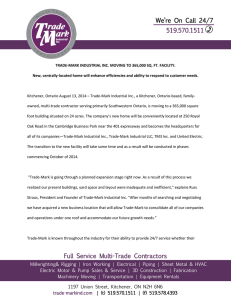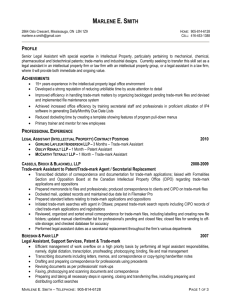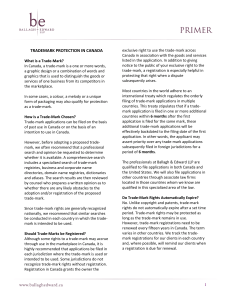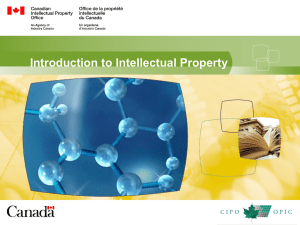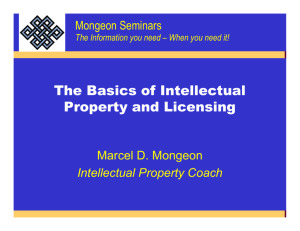A New Look at an Old Section of the Trade-Marks Act
advertisement
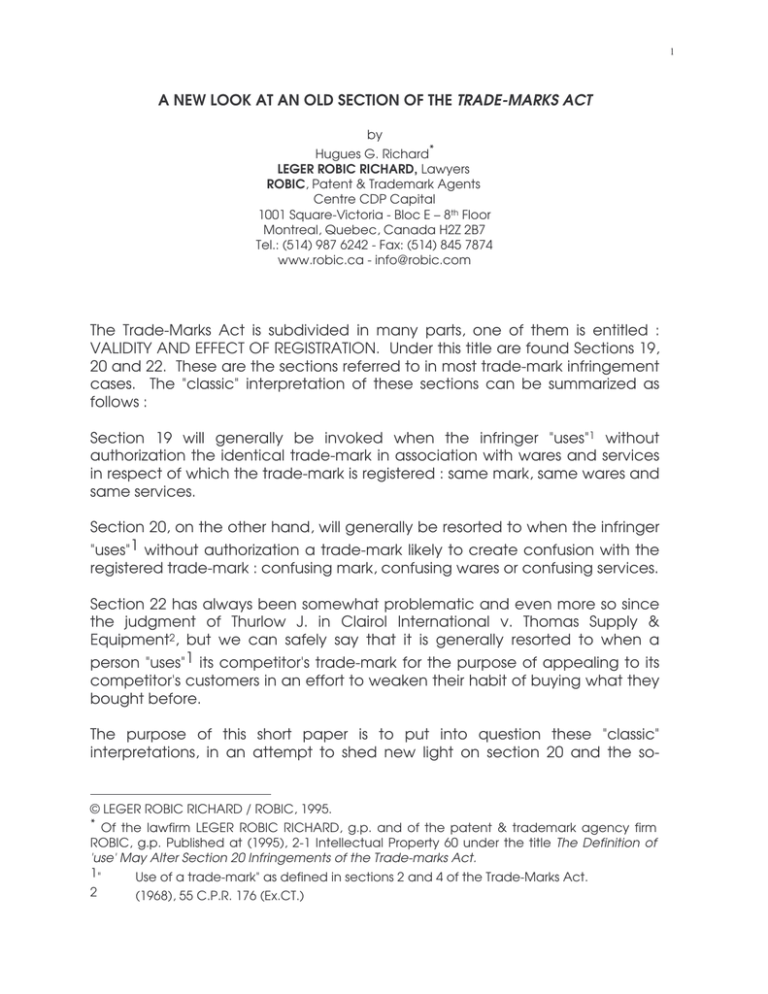
A NEW LOOK AT AN OLD SECTION OF THE TRADE-MARKS ACT by Hugues G. Richard* LEGER ROBIC RICHARD, Lawyers ROBIC, Patent & Trademark Agents Centre CDP Capital 1001 Square-Victoria - Bloc E – 8th Floor Montreal, Quebec, Canada H2Z 2B7 Tel.: (514) 987 6242 - Fax: (514) 845 7874 www.robic.ca - info@robic.com The Trade-Marks Act is subdivided in many parts, one of them is entitled : VALIDITY AND EFFECT OF REGISTRATION. Under this title are found Sections 19, 20 and 22. These are the sections referred to in most trade-mark infringement cases. The "classic" interpretation of these sections can be summarized as follows : Section 19 will generally be invoked when the infringer "uses"1 without authorization the identical trade-mark in association with wares and services in respect of which the trade-mark is registered : same mark, same wares and same services. Section 20, on the other hand, will generally be resorted to when the infringer "uses"1 without authorization a trade-mark likely to create confusion with the registered trade-mark : confusing mark, confusing wares or confusing services. Section 22 has always been somewhat problematic and even more so since the judgment of Thurlow J. in Clairol International v. Thomas Supply & Equipment2, but we can safely say that it is generally resorted to when a person "uses"1 its competitor's trade-mark for the purpose of appealing to its competitor's customers in an effort to weaken their habit of buying what they bought before. The purpose of this short paper is to put into question these "classic" interpretations, in an attempt to shed new light on section 20 and the so- © LEGER ROBIC RICHARD / ROBIC, 1995. * Of the lawfirm LEGER ROBIC RICHARD, g.p. and of the patent & trademark agency firm ROBIC, g.p. Published at (1995), 2-1 Intellectual Property 60 under the title The Definition of 'use' May Alter Section 20 Infringements of the Trade-marks Act. 1" Use of a trade-mark" as defined in sections 2 and 4 of the Trade-Marks Act. 2 (1968), 55 C.P.R. 176 (Ex.CT.) called requirement of "use" as defined in sections 2 and 4 of the Trade-Marks Act.3 Section 19 endows the owner of a registered trade-mark with certain positive rights, rights which go beyond the rights conferred by common law, it is so to speak the epicentre of the Act. It gives to the owner of a trade-mark the exclusive right to use it throughout Canada in respect of the wares or services in association with which it is registered. Nothing is said in section 19 as to the consequences for a person who would do any act contrary to its provisions. This aspect of the law is taken care of by section 53.2 which states that on the application of any interested person, the court, if it is satisfied that any act has been done contrary to the Act, may make any order that it considers appropriate in the circumstances. Taken alone sections 19 and 53.2 would not make it easy in some circumstances for the owner of a trade-mark to avail himself of the rights conferred by section 19. What happens if the trade-mark shows up in the advertising of a competitor's product or on the product itself? What if the trade-mark is used in a generic way or in a descriptive manner? What if the trade-mark used is not exactly the same as the one registered? What if the trade-mark used is the same, but the wares or services are different from those of the registration? Would such unauthorized marking by a third party be considered as acts done contrary to section 19? Probably not. This is where section 20 could come into action. It is submitted that Parliament did not want the owner of a trade-mark registered in respect of any wares or services to be trapped in, it therefore adopted a generous DEEMING provision whereby any person who sells, distributes or advertises wares or services in association with a confusing trade-mark is DEEMED to have infringed the right of the owner of a registered trade-mark to its exclusive use, as provided for under section 19. As stated by Denault J. : "In proving that its rights have been infringed, the plaintiff can also count on the protection of the Act, as s. 20 creates a presumption in favour of anyone who has a registered mark against any person who sells, distributes or advertises services in association with a confusing trade-name, whatever the class of wares or services."4 (emphasis added) Therefore under section 20, it should be sufficient for the owner of a registered trade-mark to establish that a third party sells, distributes or advertises wares or services in association with a confusing trade-mark or trade-name, in order to 3 4 See, Syntex Inc. v. Apotex Inc. (1984), 1 C.P.R. (3d) 145 Culinar Inc. v. Gestion Charaine Inc. (1987), 19 C.I.P.R., 133 at 139. shift the burden of proof on that third party who will be DEEMED to infringe the owner's trade-mark unless the third party can rebut this legal presumption through the defenses provided for in section 20. In order to reverse the burden of proof now on his shoulders the DEEMED infringer can prove that he is a person entitled to use the registered trade-mark under the Act.5 If on the other hand the third party cannot established that he is a person entitled to use the trade-mark under the Act there are still further defenses available to him, i.e. : a) he uses, in a bona fide manner, his personal name as a tradename, or b) he uses, in a bona fide manner, other than as a trade-mark, i. the geographical name of his place of business, or ii. any accurate description of the character or quality of his wares or services. The defenses provided in (a) and (b) cannot succeed if the bona fide use of his personal name as a trade-name or the bona fide use, other than as a trade-mark, of the geographical name or the accurate description, are likely to have the effect of depreciating the value of the goodwill attaching to the trade-mark. Section 20 should therefore be interpreted as a considerable advantage being given by Parliament to the owner of a registered trade-mark who, should not have to prove an unauthorized "use of a trade-mark" by a third party in order to be successful in an infringement action. The only thing that the owner should have to prove is the fact that the defendant "sells, distributes or advertises wares or services in association with a confusing trade-mark or trade-name which a fortiori should include the identical trademark. This interpretation of section 20 would avoid having to discuss the meaning of "use as a trade-mark" as it was done, in a very unsatisfactory manner, in the Clairol case (supra). It also would recognize that a person can be a trademark infringer without "using any trade-mark" as defined in sections 2 and 4 of the Act. 5 This could be done for instance by establishing that he is the assignee or licensee of the registered trade-mark, or that the registration is invalid, or that he benefits from the extinction of rights theory confirmed by section 8 of the Act etc... This fact is confirmed by the last paragraph of section 20 where it is clearly stated that a person will be DEEMED to infringe a registered trade-mark if it uses his personal name as a trade-name (and not as a trade-mark) or if it uses other than as a trade-mark a geographical name etc... in a manner likely to have the effect of depreciating the value of the goodwill attaching to the trade-mark. This interpretation of section 20 also shows that our courts may have mischaracterized the "infringer" under the Act as a unlawful "user of a trade-mark" as defined in sections 2 and 4. We are tempted to suggest that sections 2 and 4 are intended to describe the type of use which is needed of a person to become the owner of a trade-mark and not the kind of use which is needed of a person to become an infringer of a trade-mark. Not all has been said, the reflexion must continue, but if this interpretation of section 20 is right, it could have useful repercussions in comparative advertisement cases where there usually is a person advertising wares or services in association with the registered trade-mark or a confusing trademark or trade-name in a manner likely to have the effect of depreciating the value of the goodwill attaching to registered trade-mark. Section 20, according to this interpretation, has the considerable advantage over section 22 of not making reference to "use of a trade-mark" by the alledged infringer and therefore may afford a remedy to a registered owner in circumstances where relying on section 22 would likely raise bizarre distinctions such as in the Clairol case (supra) and the Eye Master Ltd v. Ross King Holdings Ltd case. In that latter case Reed J. had to admit that she found the conclusion (which she accepted) "somewhat bizarre".6 6 (1992), 3 F.C. 625, Reed J., (F.C.T.D.) at p. 630 ROBIC, un groupe d'avocats et d'agents de brevets et de marques de commerce voué depuis 1892 à la protection et à la valorisation de la propriété intellectuelle dans tous les domaines: brevets, dessins industriels et modèles utilitaires; marques de commerce, marques de certification et appellations d'origine; droits d'auteur, propriété littéraire et artistique, droits voisins et de l'artiste interprète; informatique, logiciels et circuits intégrés; biotechnologies, pharmaceutiques et obtentions végétales; secrets de commerce, knowhow et concurrence; licences, franchises et transferts de technologies; commerce électronique, distribution et droit des affaires; marquage, publicité et étiquetage; poursuite, litige et arbitrage; vérification diligente et audit; et ce, tant au Canada qu'ailleurs dans le monde. La maîtrise des intangibles. ROBIC, a group of lawyers and of patent and trademark agents dedicated since 1892 to the protection and the valorization of all fields of intellectual property: patents, industrial designs and utility patents; trademarks, certification marks and indications of origin; copyright and entertainment law, artists and performers, neighbouring rights; computer, software and integrated circuits; biotechnologies, pharmaceuticals and plant breeders; trade secrets, know-how, competition and anti-trust; licensing, franchising and technology transfers; ecommerce, distribution and business law; marketing, publicity and labelling; prosecution litigation and arbitration; due diligence; in Canada and throughout the world. Ideas live here. COPYRIGHTER IDEAS LIVE HERE IL A TOUT DE MÊME FALLU L'INVENTER! LA MAÎTRISE DES INTANGIBLES LEGER ROBIC RICHARD NOS FENÊTRES GRANDES OUVERTES SUR LE MONDE DES AFFAIRES PATENTER R ROBIC ROBIC + DROIT +AFFAIRES +SCIENCES +ARTS ROBIC ++++ ROBIC +LAW +BUSINESS +SCIENCE +ART THE TRADEMARKER GROUP TRADEMARKER VOS IDÉES À LA PORTÉE DU MONDE , DES AFFAIRES À LA GRANDEUR DE LA PLANÈTE YOUR BUSINESS IS THE WORLD OF IDEAS; OUR BUSINESS BRINGS YOUR IDEAS TO THE WORLD
